History
«Maly theatre!... It’s the Russian Academie des Sciences!
It’s a panel of the immortals!»
Alexandre Amphiteatrov (Russian publicist, playwright, journalist and literary critic)
In 1756 Elizabeth Petrovna, the Empress of Russia, decreed the establishment of Russian theatre in Saint-Petersburg. Soon, a new theatre was opened by Moscow University students who became its actors. In 1759 a Russian public theatre was opened under the jurisdiction of the Moscow University, under the management of the university director, poet and playwright Mikhail Matveyevich Kheraskov. The theater did not last long, but it became the basis for the is first permanent company in Moscow.
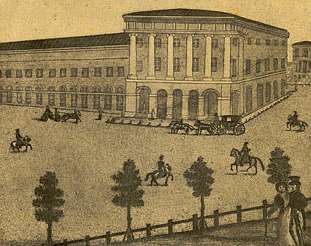 |
| The private residence of merchant Vargin, where Maly theatre was opened in 1824 |
Several decades Moscow theatre company, which included dramatic actors, singers, dancers and musicians, was led by private entrepreneurs, among which the most successful and prominent one was entrepreneur M.E.Medoksom, who built in 1780, a bigger theater, named Petrovsky (named after the square, where it was built).
Since 1806 the Petrovsky theatre company became state-owned, part of the imperial theatres, and became known as Imperial Moscow theatre. After a fire of the 1812 the theatrical troupe lost the premises and had to perform at different places – at The Pashkov House on Mokhovaya Street adjusted for the theatre, a wooden theatre near the Arbat Gate, that burnt down in 1812, and at the Apraksin mansion on Znamenka street. In 1824 the architect Joseph Bové re-built Vargin’s mansion next to the Bolshoi Theatre. The first performance took place here on 14 October 1824 and the Imperial Moscow theatre company acquired its permanent home - the Maly Theatre.
Moskovskiye Vedomosti (Moscow Gazette) newspaper published an announcement about the first play at the Maly Theatre: «The Administration of the Imperial Moscow Theater hereby announces that next Tuesday, on October 14th of the present year, at the new maly theatre, at the re-built Vargin’s mansion on Petrovskaya Square, there will be a new production of Alexey Verstovsky's Lily of Narbonne or Knight's Vow, a new dramatic chivalresque ballet performance…»
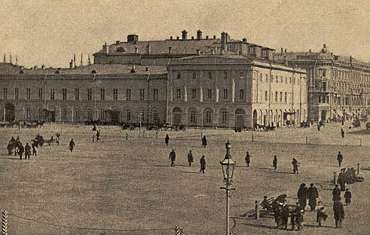
|
| Moscow Maly theatre building, the photo of 1890s |
As you can see, at first the word «maly» (small) was not even written with a capital letter, because it was simply related to the theatre’s size, compared to the Bolshoi Theatre («big» in Russian), located next door and intended for ballet and opera performances. But soon the words «Bolshoi» («Big») and «Maly» («Small») became the theatres’ proper names, which are used around the world up until now. For some time the opera and ballet troupe and drama troupe of the Imperial Moscow Theatre were a single whole: the same artist could take part in plays of all kinds, with theatre buildings being connected by an underground passage.
Within the walls of this classical building of light and elegant yet strict lines and perfect proportions the voices of outstanding artists never ceased ever since. And the audience keeps on crying and laughing, rejoicing and getting terrified, freezing with ecstasy and bursting into applause shocked at the tragic insights of the restless romantic Mochalov, admiring the cheery and lively intonations of the great Shchepkin, submitting to the intimate play and the power of the tragic talent of Prov Sadovsky, empathizing with the heroic thrill and being inspired by Ermolova’s brilliant play in one of the oldest and most beautiful auditoriums in Moscow ... An entire galaxy of unique artists that performed on the stage. Rykalova, Nikulina, Medvedeva, Fedotova, the Sadovskys artistic family, the Borozdin- Muzulei-Ryzhovs dynasty, Lensky, Yuzhin, Leshkovskaya, Yablochkina, Ostuzhev, Pashennaya, Turchaninova, Ilyinsky, Zharov, Babochkin, Tsarev ... to name a few… And every single name is a golden page in the history of the Russian theatre.
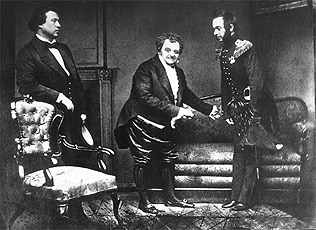
|
| I.V. Samarin-Tchatskiy, M.S. Schepkin-Famusov, G.S. Olgin-Skalozub, «Woe from wit», A. Griboyedov |
The 19th century generally became the Golden Age in history of the Maly Theatre: it staged works of remarkable Russian writers thus opening the theatre world to a broader more democratic audience. The Maly Theatre staged works of an outstanding Russian poet Pushkin while he was alive - Ruslan and Ludmila 1825, The Fountain of Bakhchisaray 1827, The Gypsies 1832. In addition to Russian classics it also staged plays of Shakespeare and Schiller. However, along with serious dramatic plays, there were also melodramas and vaudevilles in Maly Theatre’s repertoire.
One of the major events in the Maly’s history became the production of Alexander Griboyedov’s comedy «Woe from Wit» featuring both Shchepkin as Famusov and Pavel Mochalov as Chatsky. In 1830, the censorship allowed only a few scenes from the play to be displayed, and in 1831 the comedy was performed in the original version and without censorship. Nikolai Gogol’s works are also part of the Maly’s theatrical heritage. The great writer himself, hoping for an accurate interpretation of his play «The Government Inspector» at the Maly Theatrу, wrote a letter to Mikhail Shchepkin, in which he gave him advice on staging. The theatre also staged Gogol’s «Dead souls», «Marriage» and «The Gamblers». Among other Russian authors that wrote for Maly were Ivan Turgenev, who created plays «The Bachelor» and «Fortune's Fool» specifically for the theatre and Shchepkin. The famous comedy «The Wedding of Krechinsky» by Alexander Sukhovo-Kobylin was presented in the Maly Theater for the first time.
Ivan Alexandrovich Goncharov, a classic Russian novelist, addressing himself to Alexander Ostrovsky, wrote: «Only after you can we Russians say with pride: « We have our own Russian, national theatre. By rights it should be called The Theatre of Ostrovsky.» Today Ostrovsky and the Maly Theatre are two names that are inseparable from each other. Ostrovsky’s legacy cannot be underestimated. The great Russian playwright wrote 48 plays, and all of them were staged at the Maly. His writings on dramatic theory, on the state of contemporary theatre, the problems of the acting profession and his continuing place in the Russian stage repertory have been crucial for the development of Russian theatre.Ostrovsky created plays specifically for the Maly Theatre and he himself read them out to the actors. In addition, he held the rehearsals, defining the interpretation of the play and the piece of acting. Ostrovsky wrote one actor plays at a special request of the actors of the Maly Theatre.

|
| A.N. Ostrovsky, a portrait by V.G. Perov |
Ostrovsky's plays became a trademark for the theatre, and soon Maly became known as the «House of Ostrovsky.» The monument to the great Russian playwright was unveiled in 1929 in front of the Maly Theatre. In spite of all critical social, political changes or changes that are taking place in the theatre, Maly Theatre’s repertoire has always included the plays by Ostrovsky. More than 150 years ago, an indissoluble alliance was formed that remains up to this day: Ostrovsky found his theatre, and the Maly Theatrem in its turn, - its playwright.
Today, as always, the repertoire of the theatre includes the plays by Alexander Ostrovsky: «Enough Stupidity in Every Wise Man», «Truth is Good, but Happiness is Better», «The Last Sacrifice», «Wolves and Sheep», «There Was Not a Single Penny, and Suddenly There is a Dime», «The Forest», «Money to Burn», «All the Days Are not Alike», «It's a Family Affair-We'll Settle It Ourselves», «Poverty is No Vice», «Without a Dowry».
Between the 19th and 20th centuries, the theatre’s repertoire consisted of Russian and foreign classics.
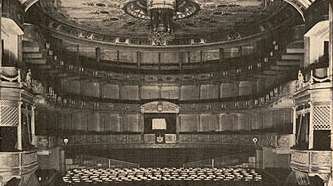
|
| The auditorium of the Moscow Maly theatre, 1916 |
The audience has always been highly interested in a traditional drama theatre, represented by the Maly. For example, Schiller’s play «The Maid of Orleans»with the great Ermolova was on Maly’s stage for 18 years, and 9 years after the premiere, in 1894, the performance moved onto Bolshoi stage because Maly could not accommodate everyone who wanted to see it. Or alternatively, from time to time the opera and ballet performances were on stage of the Maly Theatre. Tchaikovsky's «Eugene Onegin» received its première at the Maly Theatre on 17 March 1879 at a special request of the composer.
There is a belief among the actors and staff of the Maly Theatre that a strict unpretentious yellow building on the Theatre Square preserves the aura of the great artists of the past within its walls. Spirits of the past guard the theatre at its most difficult times. They helped maintaining the theatre during the post-revolutionary chaos of 1917, when the Maly theatre faced the danger of being closed by People's commissariat for theatre, as it was regarded as the object of bourgeois culture and thus supposedly not needed for the new spectator. The spirits of the Maly Theatre also helped to survive through the troubled war time and at the time of birth and death of various innovative theatre reforms, holding to its inviolable traditions. And still, the invisible guards of the theatre help their successors overcoming all the challenges and obstacles.
The years have passed, epochs have changed, new generations have come and left, but, trying to ensure continuity of traditions, the artists, who appeared on this illustrious stage, did their best to protect and develop the best realistic traditions of the oldest Russian theatre. This is how the history of the Maly Theatre and its drama school were created. The theatre art of the masters of the Moscow stage acquired those unique traits that let us speak about the significance of the Maly Theatre in the history of the drama theater. And the Maly remains a guardian of traditions, adhering to its traditions that have already became classical .The theatre’s repertoire consists of Russian and world classics and mastery of acting is the basis of acting practice.
During his lifetime Anton Chekhov did not have a strong relationship with the Maly Theatre. Despite the fact that Chekhov was on friendly terms with Maly’s actors, his works were not very favoured inter vivos. Among the plays that were staged at the Maly Theatre were «The Proposal», «The Bear», and «A jubilee». However, today Chekhov's greatest works occupy a significant place in theatre’s repertoire: «The Cherry Orchard», «The Seagull», «Three Sisters».
Aleksey Tolstoy’s dramatic trilogy «The Death of Ivan the Terrible» (1866), «Tsar Fyodor Ioannovich» (1868), and «Tsar Boris» (1870), telling the history of the Russian State became Maly Theatre’s hallmark. Music for these performances was written by a great Russian composer Georgy Sviridov specifically for the Maly Theatre. The theatre performs a large number of plays by foreign authors: William Shakespeare, W. Somerset Maugham, Carlo Goldoni, Jean-Baptiste Molière, Eugene Scribe.
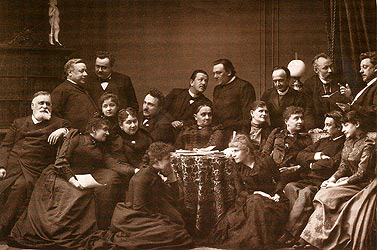
|
| Leading actors of the Maly Theatre, photo of 1891 |
In October 1995 the last major renovation of Bolshaya Ordynka stage was completed. Every day, except Monday, the performances run on both stages.
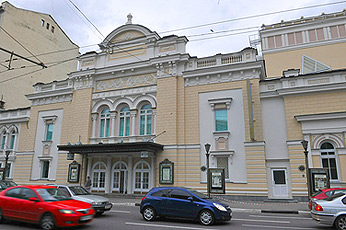
|
| Bolshaya Ordynka stage |
Today the Artistic Director of the Theatre is People’s Artist of the USSR Yuri Solomin. The theatre’s company includes a lot of popular actors People's Artist of the USSR Elina Bystritskaya, People's Artists of the Russian Federation: Yury Kayurov, Irina Muravyeva, Lyudmila Polyakova, Vasiliy Bochkaryov, Evgeniya Glushenko, Aleksandr Korshunov, Svetlana Amanova, Boriz Nevzorov, Aleksandr Klukvin, Vladimir Nosik and many other prominent artists. The theatre’s company consists of more than 100 actors, and the total number of the Maly’s staff is over 700 people. The Maly Theatre has preserved its orchestra that includes highly professional musicians, laureates of international competitions.
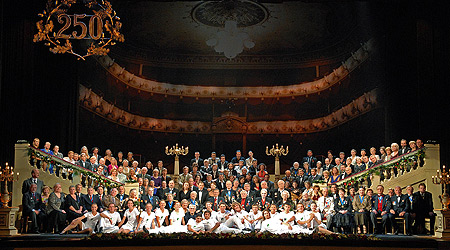
|
| Maly Theatre's company in the year of 250 anniversary of the Russian theatre |
Each season the Maly Theatre releases several new performances and takes off some old productions. Furthermore, for the past few years the Maly Theatre expanded its tour geography: Finland, Italy, Germany, France, Japan, Israel, Greece, Cyprus, Poland, Czech Republic, Slovakia, Hungary, Bulgaria, Mongolia, South Korea and other countries. Apart from touring, the Maly Theatre also holds a festival «Ostrovsky in the House of Ostrovsky» that is dedicated to the work of the great Russian playwright Alexander Ostrovsky. The festival’s mission is to support Russian provincial theatres fertile in talented actors and directors. Theatres from different cities and regions of Russia present their productions of the great playwright on the stage of the Maly Theatre. In 2010, the Maly Theatre joined the Union of European Theatres (UTE) and in 2012 held the International Festival of UTE, which was attended by companies from Israel, Greece, Romania and Italy.
During the Great Patriotic War, the Maly Theatre did not stand aside from the global struggle for the Victory. Artists of the theatre were among the first ones to take part in the work of front-line units, performing in military units and hospitals. In 1943 the Front-line branch of the Maly Theatre was created, whose task was the artistic service of the active units of the army. Over 2700 front-line performances and concerts of the Maly Theatre units and its Front-line branch were given during the war.
The funds raised by the theatre’s staff in 1944 became the source for building the squadron that was handed over to the army and called the «The Maly Theatre to front». From October 1944 to May 1945, the squadron defeated the enemy in the sky over East Prussia.
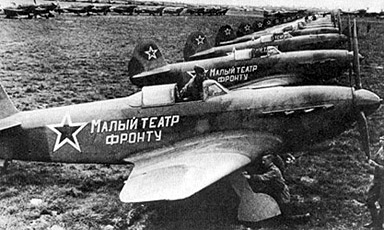
|
| Squadron « From The Maly Theatre to front» |
In the summer of 2010 the Maly Theatre went on a charitable tour of 8 cities of the Volga region «The Maly Theatre – the Great Victory!», dedicated to the 65th anniversary of the Victory in the Great Patriotic War and the 150th anniversary of Anton Chekhov's birth.
In 1992 according to the decree of the President of Russia the theater was awarded the National Treasure status along with Bolshoi Theatre, the Hermitage, The State Tretyakov Gallery and Saint Basil's Cathedral. The Maly Theatre has always been a symbol of a dramatic theatrical art and the immortal guardian of ancient traditions of the oldest theatre school in Russia.
















